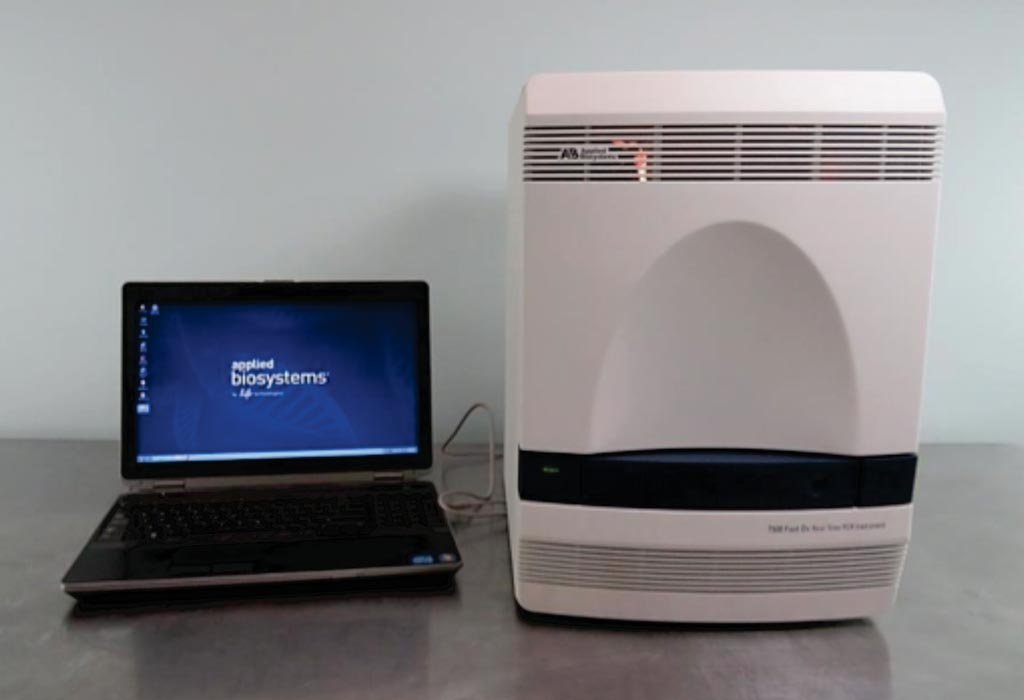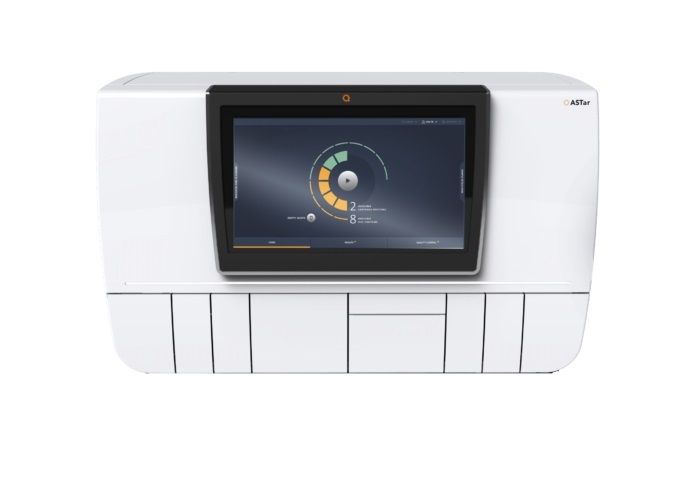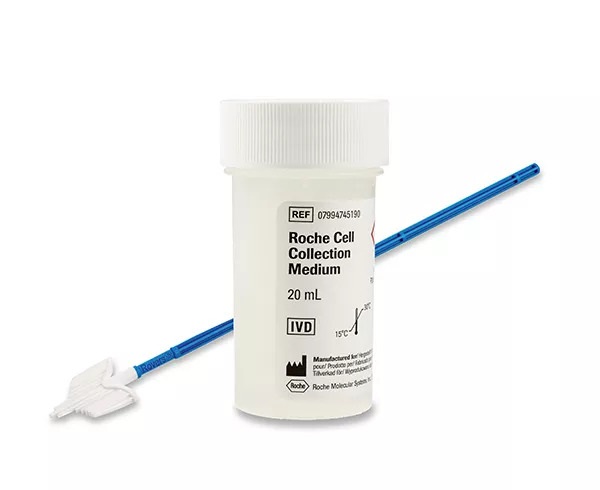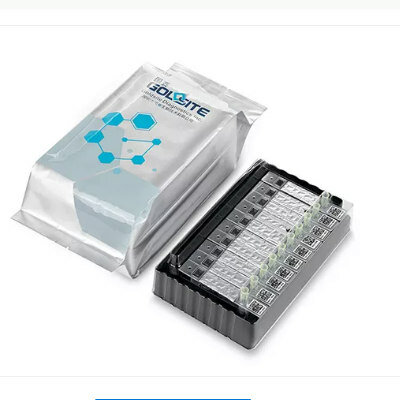Molecular Diagnostics Prevents Malaria in Blood Banks
|
By LabMedica International staff writers Posted on 18 Oct 2018 |

Image: The ABI 7500 Real-Time PCR system (Photo courtesy of Applied Biosystems).
Haemovigilance is required to identify and prevent the occurrence or recurrence of unwanted transfusion-related transmissions and to increase the safety, efficacy and efficiency of blood transfusions.
Malaria can be transmitted by blood transfusion through donations collected from asymptomatic or parasitic donors. The parasites are released into the bloodstream during its life cycle and will therefore be present in donated blood by infected individuals and can be fatal to the recipient.
Brazilian scientists collaborating with the Federal University of Pará (Belem, Brazil) obtained positive samples of Plasmodium vivax (22,000 parasites/µL) and P. malariae (400 parasites/µL) were obtained from patients with malaria and a positive sample of P. falciparum. Samples of potential donors were collected in two blood bank centers and among them, 1,324 were obtained from nine reference units and 900 were collected from blood donors in Porto Velho.
DNA samples were extracted from 150 µL blood by phenol/chloroform followed by ethanol precipitation method, with modifications. The DNA was quantified on NanoDrop ND 1000, in 260 nm to 280 nm wavelength range and final concentration was adjusted to 100 ng/µL. A real-time polymerase chain reaction (mt-qPCR) was performed to determine the presence and absence of the malaria parasite mitochondrial (mtDNA), based on primer extension and posterior hybridization with TaqMan probes on ABI Prism 7500 sequence detection system.
The team reported that malaria parasites were detected in 10 of 2,224 blood donors (0.45%). In all 10 positive samples, only P. vivax mtDNA was detected. The positivity for Plasmodium was observed in only three blood banks. The mt-qPCR was highly efficient, and the analytic sensitivity for P. vivax was determined (0.000006 parasites/µL). In samples collected in Porto Velho, only P. vivax was detected using both molecular diagnostic methods (mtDNA and 18S rRNA).
The authors concluded mt-qPCR is efficient for malaria molecular diagnostics, presenting promising results with good analytic sensitivity. It is a fast and easy molecular methodology to detect mtDNA of the three most frequent malaria parasites, presenting a potential for large-scale use in the prevention of transfusion-transmitted malaria by screening for potential donors as part of malaria haemovigilance in blood banks. The study was published on October 1, 2018, in the Malaria Journal.
Related Links:
Federal University of Pará
Malaria can be transmitted by blood transfusion through donations collected from asymptomatic or parasitic donors. The parasites are released into the bloodstream during its life cycle and will therefore be present in donated blood by infected individuals and can be fatal to the recipient.
Brazilian scientists collaborating with the Federal University of Pará (Belem, Brazil) obtained positive samples of Plasmodium vivax (22,000 parasites/µL) and P. malariae (400 parasites/µL) were obtained from patients with malaria and a positive sample of P. falciparum. Samples of potential donors were collected in two blood bank centers and among them, 1,324 were obtained from nine reference units and 900 were collected from blood donors in Porto Velho.
DNA samples were extracted from 150 µL blood by phenol/chloroform followed by ethanol precipitation method, with modifications. The DNA was quantified on NanoDrop ND 1000, in 260 nm to 280 nm wavelength range and final concentration was adjusted to 100 ng/µL. A real-time polymerase chain reaction (mt-qPCR) was performed to determine the presence and absence of the malaria parasite mitochondrial (mtDNA), based on primer extension and posterior hybridization with TaqMan probes on ABI Prism 7500 sequence detection system.
The team reported that malaria parasites were detected in 10 of 2,224 blood donors (0.45%). In all 10 positive samples, only P. vivax mtDNA was detected. The positivity for Plasmodium was observed in only three blood banks. The mt-qPCR was highly efficient, and the analytic sensitivity for P. vivax was determined (0.000006 parasites/µL). In samples collected in Porto Velho, only P. vivax was detected using both molecular diagnostic methods (mtDNA and 18S rRNA).
The authors concluded mt-qPCR is efficient for malaria molecular diagnostics, presenting promising results with good analytic sensitivity. It is a fast and easy molecular methodology to detect mtDNA of the three most frequent malaria parasites, presenting a potential for large-scale use in the prevention of transfusion-transmitted malaria by screening for potential donors as part of malaria haemovigilance in blood banks. The study was published on October 1, 2018, in the Malaria Journal.
Related Links:
Federal University of Pará
Latest Hematology News
- Next Generation Instrument Screens for Hemoglobin Disorders in Newborns
- First 4-in-1 Nucleic Acid Test for Arbovirus Screening to Reduce Risk of Transfusion-Transmitted Infections
- POC Finger-Prick Blood Test Determines Risk of Neutropenic Sepsis in Patients Undergoing Chemotherapy
- First Affordable and Rapid Test for Beta Thalassemia Demonstrates 99% Diagnostic Accuracy
- Handheld White Blood Cell Tracker to Enable Rapid Testing For Infections
- Smart Palm-size Optofluidic Hematology Analyzer Enables POCT of Patients’ Blood Cells
- Automated Hematology Platform Offers High Throughput Analytical Performance
- New Tool Analyzes Blood Platelets Faster, Easily and Accurately
- First Rapid-Result Hematology Analyzer Reports Measures of Infection and Severity at POC
- Bleeding Risk Diagnostic Test to Reduce Preventable Complications in Hospitals
- True POC Hematology Analyzer with Direct Capillary Sampling Enhances Ease-of-Use and Testing Throughput
- Point of Care CBC Analyzer with Direct Capillary Sampling Enhances Ease-of-Use and Testing Throughput
- Blood Test Could Predict Outcomes in Emergency Department and Hospital Admissions
- Novel Technology Diagnoses Immunothrombosis Using Breath Gas Analysis
- Advanced Hematology System Allows Labs to Process Up To 119 Complete Blood Count Results per Hour
- Unique AI-Based Approach Automates Clinical Analysis of Blood Data
Channels
Clinical Chemistry
view channel
3D Printed Point-Of-Care Mass Spectrometer Outperforms State-Of-The-Art Models
Mass spectrometry is a precise technique for identifying the chemical components of a sample and has significant potential for monitoring chronic illness health states, such as measuring hormone levels... Read more.jpg)
POC Biomedical Test Spins Water Droplet Using Sound Waves for Cancer Detection
Exosomes, tiny cellular bioparticles carrying a specific set of proteins, lipids, and genetic materials, play a crucial role in cell communication and hold promise for non-invasive diagnostics.... Read more
Highly Reliable Cell-Based Assay Enables Accurate Diagnosis of Endocrine Diseases
The conventional methods for measuring free cortisol, the body's stress hormone, from blood or saliva are quite demanding and require sample processing. The most common method, therefore, involves collecting... Read moreMolecular Diagnostics
view channel
Game-Changing Blood Test for Stroke Detection Could Bring Life-Saving Care to Patients
Stroke is the primary cause of disability globally and ranks as the second leading cause of death. However, timely early intervention can prevent severe outcomes. Most strokes are ischemic, resulting from... Read moreBlood Proteins Could Warn of Cancer Seven Years before Diagnosis
Two studies have identified proteins in the blood that could potentially alert individuals to the presence of cancer more than seven years before the disease is clinically diagnosed. Researchers found... Read moreImmunology
view channel.jpg)
AI Predicts Tumor-Killing Cells with High Accuracy
Cellular immunotherapy involves extracting immune cells from a patient's tumor, potentially enhancing their cancer-fighting capabilities through engineering, and then expanding and reintroducing them into the body.... Read more
Diagnostic Blood Test for Cellular Rejection after Organ Transplant Could Replace Surgical Biopsies
Transplanted organs constantly face the risk of being rejected by the recipient's immune system which differentiates self from non-self using T cells and B cells. T cells are commonly associated with acute... Read more
AI Tool Precisely Matches Cancer Drugs to Patients Using Information from Each Tumor Cell
Current strategies for matching cancer patients with specific treatments often depend on bulk sequencing of tumor DNA and RNA, which provides an average profile from all cells within a tumor sample.... Read more
Genetic Testing Combined With Personalized Drug Screening On Tumor Samples to Revolutionize Cancer Treatment
Cancer treatment typically adheres to a standard of care—established, statistically validated regimens that are effective for the majority of patients. However, the disease’s inherent variability means... Read moreMicrobiology
view channel
Integrated Solution Ushers New Era of Automated Tuberculosis Testing
Tuberculosis (TB) is responsible for 1.3 million deaths every year, positioning it as one of the top killers globally due to a single infectious agent. In 2022, around 10.6 million people were diagnosed... Read more
Automated Sepsis Test System Enables Rapid Diagnosis for Patients with Severe Bloodstream Infections
Sepsis affects up to 50 million people globally each year, with bacteraemia, formerly known as blood poisoning, being a major cause. In the United States alone, approximately two million individuals are... Read moreEnhanced Rapid Syndromic Molecular Diagnostic Solution Detects Broad Range of Infectious Diseases
GenMark Diagnostics (Carlsbad, CA, USA), a member of the Roche Group (Basel, Switzerland), has rebranded its ePlex® system as the cobas eplex system. This rebranding under the globally renowned cobas name... Read more
Clinical Decision Support Software a Game-Changer in Antimicrobial Resistance Battle
Antimicrobial resistance (AMR) is a serious global public health concern that claims millions of lives every year. It primarily results from the inappropriate and excessive use of antibiotics, which reduces... Read morePathology
view channel
New AI Tool Classifies Brain Tumors More Quickly and Accurately
Precision in diagnosing and categorizing tumors is essential for delivering effective treatment to patients. Currently, the gold standard for identifying various types of brain tumors involves DNA methylation-based... Read more
AI Integrated With Optical Imaging Technology Enables Rapid Intraoperative Diagnosis
Rapid and accurate intraoperative diagnosis is essential for tumor surgery as it guides surgical decisions with precision. Traditional intraoperative assessments, such as frozen sections based on H&E... Read more
HPV Self-Collection Solution Improves Access to Cervical Cancer Testing
Annually, over 604,000 women across the world are diagnosed with cervical cancer, and about 342,000 die from this disease, which is preventable and primarily caused by the Human Papillomavirus (HPV).... Read moreHyperspectral Dark-Field Microscopy Enables Rapid and Accurate Identification of Cancerous Tissues
Breast cancer remains a major cause of cancer-related mortality among women. Breast-conserving surgery (BCS), also known as lumpectomy, is the removal of the cancerous lump and a small margin of surrounding tissue.... Read moreTechnology
view channel
New Diagnostic System Achieves PCR Testing Accuracy
While PCR tests are the gold standard of accuracy for virology testing, they come with limitations such as complexity, the need for skilled lab operators, and longer result times. They also require complex... Read more
DNA Biosensor Enables Early Diagnosis of Cervical Cancer
Molybdenum disulfide (MoS2), recognized for its potential to form two-dimensional nanosheets like graphene, is a material that's increasingly catching the eye of the scientific community.... Read more
Self-Heating Microfluidic Devices Can Detect Diseases in Tiny Blood or Fluid Samples
Microfluidics, which are miniature devices that control the flow of liquids and facilitate chemical reactions, play a key role in disease detection from small samples of blood or other fluids.... Read more
Breakthrough in Diagnostic Technology Could Make On-The-Spot Testing Widely Accessible
Home testing gained significant importance during the COVID-19 pandemic, yet the availability of rapid tests is limited, and most of them can only drive one liquid across the strip, leading to continued... Read moreIndustry
view channel
Danaher and Johns Hopkins University Collaborate to Improve Neurological Diagnosis
Unlike severe traumatic brain injury (TBI), mild TBI often does not show clear correlations with abnormalities detected through head computed tomography (CT) scans. Consequently, there is a pressing need... Read more
Beckman Coulter and MeMed Expand Host Immune Response Diagnostics Partnership
Beckman Coulter Diagnostics (Brea, CA, USA) and MeMed BV (Haifa, Israel) have expanded their host immune response diagnostics partnership. Beckman Coulter is now an authorized distributor of the MeMed... Read more_1.jpg)









 Reagent.jpg)


_1.jpg)
